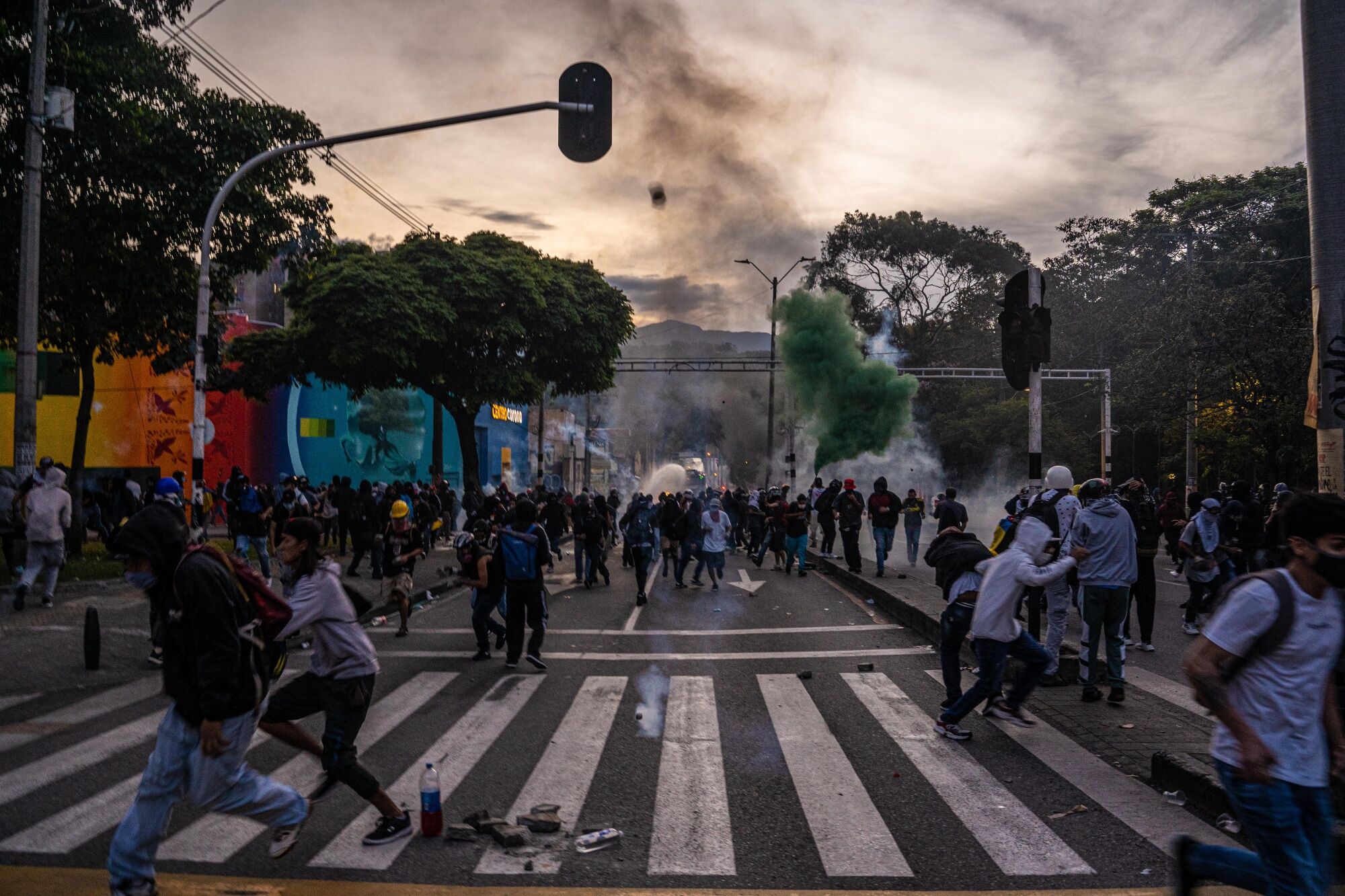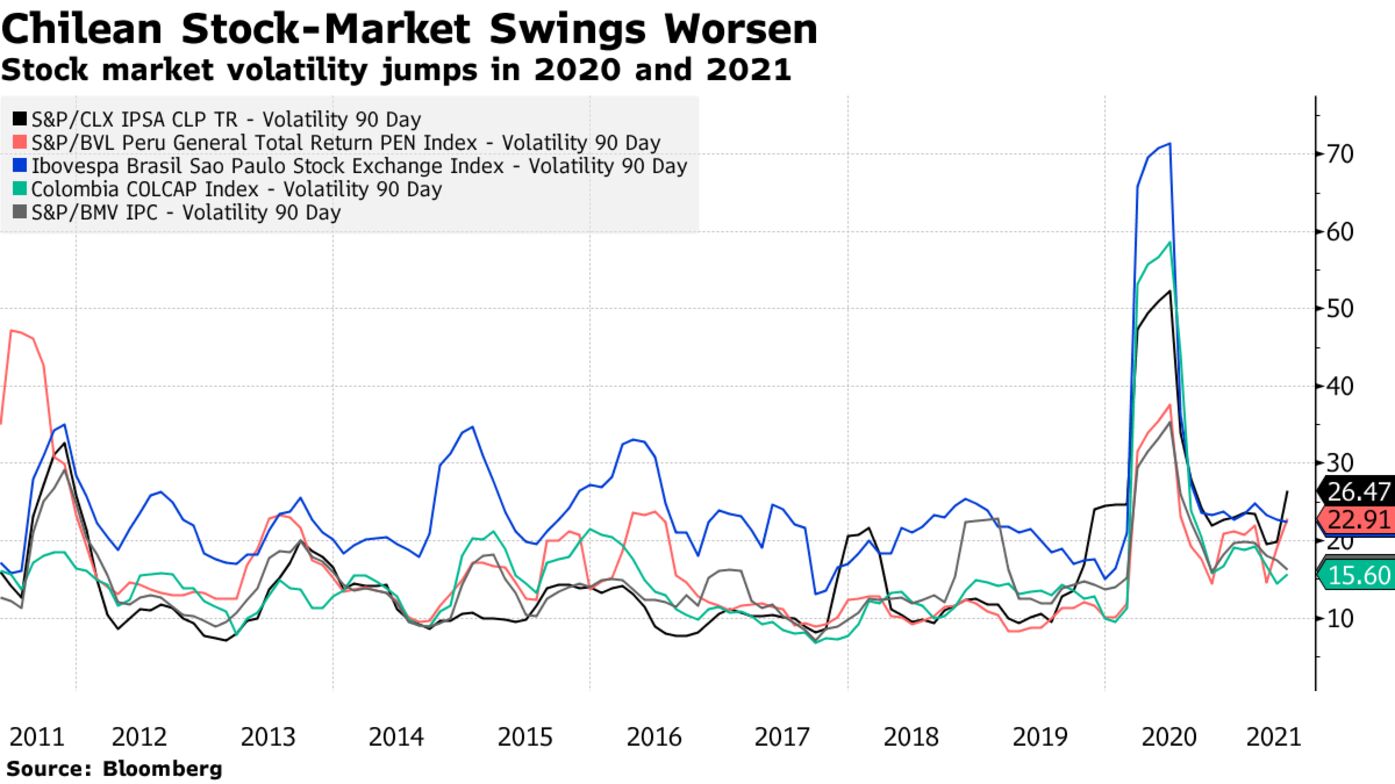Markets
Safe Havens Take Hit in South America as Pandemic Sparks Unrest
By , , and- Chile, Peru and Colombia no longer the outliers they once were
- Currencies, bonds, stocks have suffered as leftists take power
For years, it’s been easy for investors to divide South America into two camps. One was the perennial misfits, countries like Argentina, Ecuador and Venezuela, where constant turmoil roiled economies and upended businesses. Then there were the oases of stability, most notably Chile, Colombia and Peru, where drama was minimal and money managers could feel fairly safe.
But suddenly those Andean havens are looking a bit unsettled themselves, and markets aren’t taking it well. Even before the country was cut to junk last week, Colombia’s local bonds were the worst in emerging markets after a clumsy attempt to raise taxes fueled an eruption of street protests. Peru’s currency has been battered as an avowed Marxist took the lead in presidential election polls. Chile’s stock market is the world’s worst performer after the establishment was roundly defeated in a vote to select officials to rewrite the constitution.
The political turmoil can be seen as the opening salvo in an anti-establishment push across the region after the pandemic hit Latin America and exacerbated inequality like nowhere else. Now, after a steady expansion in the middle class earlier this century, citizens are demanding more social support and a rethinking of pro-business policies that prioritized economic growth above all else.
The shift in Andean politics hasn’t been so much a right-versus-left realignment, but rather a rejection of whoever was in power amid the economic devastation caused by the coronavirus pandemic and what was perceived as a sluggish response. If investors used to know what to expect from government officials even if policies weren’t ideal, that predictability is now sorely missed.
“The clear, common thread has been one of steady and rising discontent with the political establishment,” said Patrick Esteruelas, the head of research at Emso Asset Management, which oversees $6 billion in securities. “There has been a clear punishment against the incumbent or the party that’s associated with the established political hierarchy in favor of politicians who can best portray themselves as agents of change.”
The region’s politics “are clearly a credit negative” that will weigh on corporate and government bonds, Citigroup Inc. analysts Eric Ollom and Donato Guarino said May 20. Deutsche Bank said Andean currencies will underperform Latin American peers over the next month. Morgan Stanley warned that more cuts are coming and losses for bondholders may worsen after S&P Global Ratings downgraded Colombia’s credit rating to junk this month.
Andean Currencies Left Behind
BRL and MXN come on top in last three months
Bloomberg
In the currency market -- generally thought of the best financial gauge of an economy’s health and stability -- Argentina’s peso plummeted 85% and Brazil’s real lost a third of its value in the past five years. By contrast, Chile’s peso weakened less than 5%. Before the pandemic, Peru’s sol had traded within a band of 3.2 and 3.4 per dollar for four years, a move of less than 7% from top to bottom. Colombia’s currency, while more volatile, mostly just moved in line with the price of oil, its major export.
In Peru, support for left-wing candidate Pedro Castillo comes mostly from the rural areas, which have been historically ignored by the government in Lima. On the other side on the presidential runoff set for June is Keiko Fujimori, a right-wing figure who has presented herself as a pro-business candidate to boost investor confidence.
Chile, long known as the region’s most stable country and its best credit risk, was shaken in October 2019 after protests against a rise in metro fares morphed into massive social unrest. Officials reacted by promising a new constitution, and in a vote this month Chileans handed control of the assembly writing the charter to fringe politicians instead of the broader coalitions that governed since the end of the country’s dictatorship. Meanwhile, Communist Party hopeful Daniel Jadue has jumped to the top of the latest opinion poll ahead of Chile’s presidential election in November.
In Colombia, the government of Ivan Duque may have been too aggressive with a fiscal overhaul that sought to increase taxes in the middle of the pandemic. This led to massive demonstrations, the resignation of his finance minister this month and scrapping the original plans. Gustavo Petro, a former guerrilla and ex-mayor of Bogota who has proposed major overhauls to the economy, is leading in polls before May’s presidential vote.
Colombia was “trying to do too much of the right thing too quickly,” said Kumaran Damodaran, an emerging-markets portfolio manager at Stone Harbor in London. “The population just wasn’t ready.”
Pedro Castillo greets supporters during a campaign rally on May 22.
Photographer: Raul Sifuentes/Getty Images
In Peru, Esteruelas says that as much as assets have sold off, there could be more pain to come should leftist Pedro Castillo win the presidency. The market “seriously under-appreciates the downside risk,” he said.
Of course things are far from perfect in Mexico and Brazil, Latin America’s biggest economies, amid a turn to populist government in those countries. Mexican markets have proved largely resilient, while Brazil has suffered more amid one of the world’s deadliest Covid outbreaks.
Some asset managers say the Andean selloffs may soon create a buying opportunity for investors willing to stomach the volatility. Klaus Kaempfe, head of asset allocation at Credicorp Capital in Santiago, says Chile and Peru will be attractive as the outlook for elections gets clearer, while it may take longer for Colombia.
Guido Chamorro, a money manager at Pictet, expects to see “some big selloffs” of assets in the region as investors react to the political risk. Yet, large rallies may follow as the market spots opportunities to buy.
“I view Latin America in 2021 as a paradise for active fund managers,” said Chamorro, co-head of emerging-market hard-currency debt at Pictet in London.
As sovereign bond defaults pile up in other parts of Latin America, it’s hurting sentiment across the region. The cost to hedge against losses on overseas securities from the Andes has climbed. Some investors say returning to the stability that Chile, Colombia and Peru are known for may take a while.
“Pressure on governments can quickly spiral into social unrest,” Tom Donilon, chairman of the BlackRock Investment Institute, wrote in a report Friday. “All of this could have significant long-term implications, including democratic backsliding or populist outcomes in elections as citizens lose trust in their leaders’ ability to steer their countries out of the pandemic.”
— With assistance by Sebastian Boyd, Sydney Maki, and Ana Maria Cervante






Keine Kommentare:
Kommentar veröffentlichen